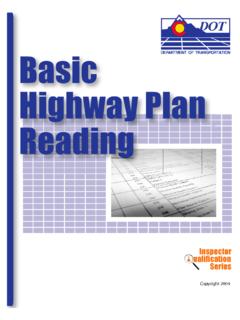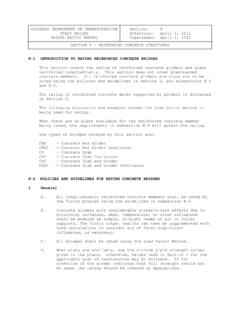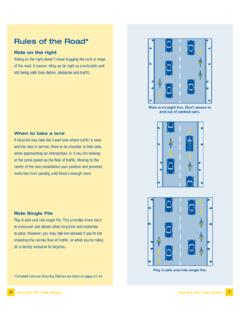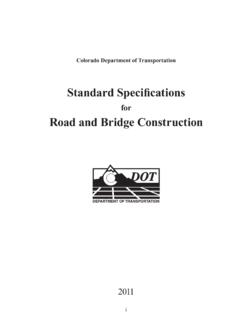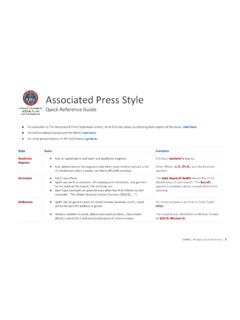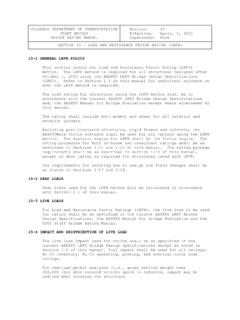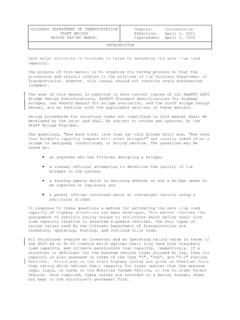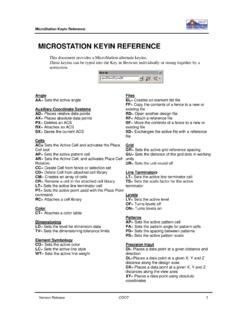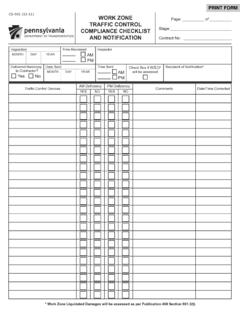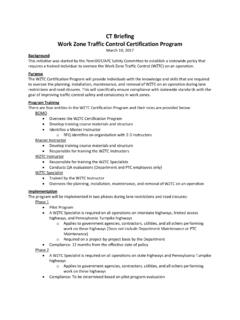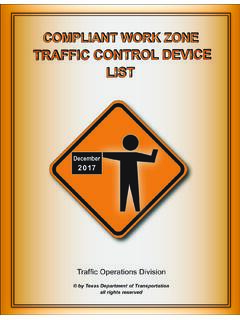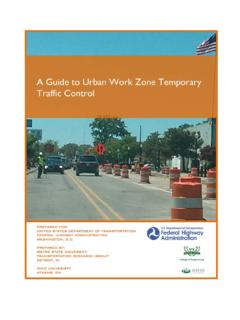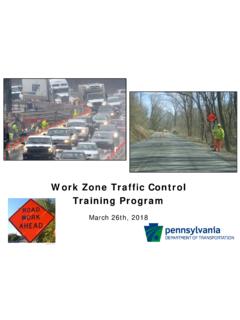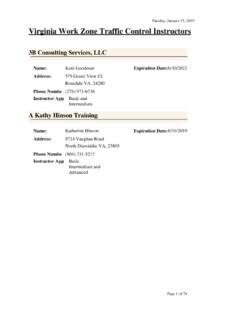Transcription of Work Zone Safety and Mobility Rule - CDOT
1 CDOT work Zone Safety and Mobility Rule Procedures Document July 2014 Revised August 2019 Acknowledgements Marcee Allen (FHWA Region 8) Kevin Ashoury (CDOT Maintenance) Larry Brinck (CDOT (Project Development) Mindy Crane (CDOT Public Information) Ken DePinto (CDOT ITS) Toni Gatzen (CDOT Public Information) Larry Haas (CDOT Region 4) Jake Kononov (CDOT Research) San Lee (CDOT Safety & traffic Engineering) Ken Nakao (CDOT Safety & traffic Engineering) KC Matthews (CDOT Safety & traffic Engineering) Keith Powers (CDOT Region 5) Kevin Radel (CDOT Region 1) Ronnie Roybal (CDOT Safety & traffic Engineering) Nancy Shanks (CDOT Public Information) Roy Smith (CDOT Region 6 Maintenance) Gabriela Vidal (CDOT Safety & traffic Engineering) Roland Wagner (CDOT Region 3) i Table of Contents 1 OVERVIEW OF TMP DEVELOPMENT.)
2 1 SCOPE, CONTENT, AND DEGREE OF DETAIL .. 1 Significant Project .. 1 Determination of Significant Projects Flow Chart .. 3 traffic control Plan (TCP) .. 3 Transportation Operations (TO) Component .. 4 Public Information (PI) Component .. 4 SIGNIFICANT PROJECT PROCEDURES .. 5 DEVELOPMENT AND IMPLEMENTATION OF THE TMP .. 7 TMP Development During Preliminary Engineering and Design .. 7 TMP Implementation and Monitoring During Construction .. 8 Post-Construction Performance Evaluation .. 8 QUALITY ASSURANCE REVIEWS FOR work ZONE traffic control ( traffic control REVIEWS) .. 9 Introduction .. 9 traffic control Review Procedures .. 9 REPORTING .. 10 TMP CONTENT .. 12 Project Description .. 12 Project TMP Roles and Responsibilities .. 12 Existing and Future Conditions .. 13 work Zone Impacts Assessment .. 13 work Zone Impacts Management Strategies.
3 13 TMP Monitoring .. 14 Monitoring Requirements .. 14 Evaluation Report Requirements: .. 14 Performance Monitoring .. 15 TMP Performance Evaluation .. 16 Debriefing Process .. 16 traffic Incident Management Plan .. 17 Key Findings .. 17 Appendices .. 17 LIST OF work ZONE STRATEGIES .. 18 TEMPORARY traffic control PLAN (TCP) STRATEGIES .. 18 Construction Management Techniques .. 23 Other Strategies .. 24 ii TRANSPORTATION OPERATIONS (TO) STRATEGIES .. 25 Travel Demand Management .. 25 Corridor/Network Management .. 26 work Zone Safety Management .. 28 traffic Incident Management and Speed Enforcement .. 30 PUBLIC INFORMATION (PI) STRATEGIES .. 33 Public Awareness .. 33 Motorist Information Strategies .. 34 Training .. 36 work ZONE Safety AND Mobility traffic QUEUING FORM .. 50 Page 1 of 58 INTRODUCTION A Transportation Management Plan (TMP) lays out a set of coordinated strategies and describes how these strategies will be used to manage the work zone impacts of a project.
4 The key to a successful TMP is early development in the project s life-cycle and the use of a multidisciplinary approach. More details about the TMP can be found in Section of the CDOT Standard Specifications for Road and Bridge Construction. TMP development occurs during the preliminary engineering and design phases of a project. During project development ( , preliminary engineering), the potential work zone impacts of a project should be assessed and work zone transportation management strategies and associated costs identified. The level of detail of this assessment may increase as more project specific information becomes available. The TMP development process is intended to work in an iterative manner that helps identify the work zone impacts of a project, given a certain combination of construction phasing and impacts management strategies.
5 The scope, content, and degree of detail of a TMP may vary based on the expected work zone impacts of the project. Additional information and examples of TMPs can be found in the FHWA TMP development resource website at the following URL: OVERVIEW OF TMP DEVELOPMENT TMP development occurs during the preliminary engineering and design phases of a project. During project development ( , preliminary engineering), the potential work zone impacts of a project should be assessed and work zone transportation management strategies and associated costs identified. The level of detail of this assessment may increase as more project specific information becomes available. The TMP development process is intended to work in an iterative manner that helps identify the work zone impacts of a project, given a certain combination of construction phasing and impacts management strategies.
6 SCOPE, CONTENT, AND DEGREE OF DETAIL The TMP consists of strategies to manage the work zone impacts of a project. Its scope, content, and degree of detail may vary based on the expected work zone impacts of the project. All projects must comply with the Region s Lane Closure Policy. The Region traffic Engineer must approve all work that does not comply with the Region s Lane Closure Policy. Significant Project A significant project is defined as one that, alone or in combination with other concurrent projects nearby, is anticipated to cause sustained work zone impacts at a location for three or more consecutive days with either intermittent or continuous lane closures. A significant project impacts the traveling public at the metropolitan, regional or the Interstate level and has a moderate to very high level of public interest.
7 It will directly impact a moderate to very large number of travelers and will have moderate to very high user cost impacts. Page 2 of 58 For significant projects, the TMP consists of three components: a traffic control Plan (TCP), Transportation Operations (TO), and Public Information (PI). For individual projects or classes of projects that are not classified as significant, the TMP, at a minimum, will consist of a TCP. The TO and PI components are optional but should always be considered. TMP Components TCP PI TO Significant Projects Required Required (The Project must obtain written approval from the FHWA to be exempt from this requirement) Required Comply with the requirements of the project regions Lane Closure Policy (The Project must obtain written approval from the FHWA to be exempt from this requirement) Non-Significant Projects Required If ANY of the following characteristics applies, a PI is REQUIRED: High level of Public Interest Significant impact on public/private access ( businesses, communities, park & ride lots, schools, fire stations, etc.)
8 Project timing ( special events, etc.) that will result in an increase in traffic volumes If NONE of the above apply, PI is Optional Must comply with the requirements of the project region s Lane Closure Policy* * A full TO analysis is required if the Region does not have a lane closure policy. Page 3 of 58 Scope the project Determination of Significant Projects Flow Chart Yes No Yes No No Yes Yes Is Project on interstate system within the boundaries of a designated Transportation Management Area (TMA) that occupies a location for MINIMUM of three (3) days with either intermittent or continuous lane closures? Is Project is expected to cause sustained work zone impacts that is greater than what is considered tolerable based on CDOT policy and/or engineering judgment?
9 Project is Non-Significant Develop TCP (CONDITIONAL) Develop PI Comply with Region LANE CLOSURE POLICY Is Project on US or State highways with ADT > 20,000? -or- Is project expected to impact public at metropolitan, regional or interstate level for MINIMUM of three (3) days with either intermittent or continuous lane closures? Project is Non-Significant Develop TCP (CONDITIONAL) Develop PI Comply with Region LANE CLOSURE POLICY Project is Significant Develop TMP (includes TCP + TO + PI) Page 4 of 58 traffic control Plan (TCP) Construction phasing greatly affects the Safety and Mobility of work zone users. It is important that designers and construction engineers who develop the construction phasing plans consult and appropriately involve Safety experts, traffic engineers and other technical specialists in the project development process.
10 Construction phasing and traffic control plans (TCPs) must be developed concurrently. A review should be conducted to verify the feasibility of the TCP and phasing. Transportation Operations (TO) and Public Information (PI) components should be considered at the same time as construction phasing and TCP development to generate a well-thought-out TMP. The best TMP development process involves developing and evaluating the best combination of project design, TCP, TO strategies, PI strategies, and construction phasing. The TCP describes measures to be used for guiding road users through a work zone or an incident area. The TCP plays a vital role in providing continuity of reasonably safe and efficient road user flow and highway worker Safety when a work zone, incident, or other event temporarily disrupts normal road user flow.

